Spiky plants are great additions to any indoor houseplant collection, as centerpieces of rock gardens or planted outdoors for added home security. They are remarkably easy to care for and have an appearance that sets them apart from the leafier plant options available at garden centers. Below, we'll let you know why you should have a spiky houseplant, how to care for them, and what selection of spiky plants you can add indoors or in your garden.
Benefits Of Spiky Houseplants
With all of the various house plants available, why choose a spiky plant? Many benefits are common to all houseplants, such as purifying the air and absorbing carbon dioxide. However, many benefits are unique to spiky plants!
Unique Aesthetic
Spiky plants have a geometric, edgy, architectural feel to them. They are the perfect choice for homes with an industrial design aspect that other house plants would clash with.
Removing Air Pollutants
All plants remove air pollutants, but studies have shown that plants with spiky leaves or heavy, fleshy leaves (like succulents) do much better at purifying the air.
Fighting Allergies
If you struggle with hives or other skin allergies, you must have an aloe vera or snake plant in your home! The leaves of both of these plants work as a topical antihistamine.
Low Maintenance
We go into this more below, but you really won't be able to find any potted plants more low maintenance than spiky plants. They also often thrive on mild neglect, so you won't need to worry if you forget to water them often!
Home Security
Yes, seriously! Set a couple of cacti under your first-floor windows, and anyone wanting to break in will likely look for another route - and probably trip an alarm in the process.
Basic Care Requirements For Plants With Spiky Leaves
Spiky plants are perfect for people who just can't be bothered dealing with a detailed watering schedule. They are incredibly low maintenance - but they still need proper care. Below are some care requirements that are universal across all spiky plants.
Light
Spiky plants can tolerate direct sunlight that would kill other plants. However, some types will only handle that much sun exposure for short periods. If you have your plant on a windowsill that gets full sun most of the day and notice leaf damage, move your spiky plant somewhere with partial shade. Keep in mind that no spiky plant thrives in full shade conditions.
Water
Spiky plants need significantly less water than other potted plants and are remarkably drought resistant. Check that the upper inches of the soil are dry before watering, and use mineral water if you can as they are prone to root rot.
Temperature
Many spiky plant species are native to warm climates - either desert or tropical. When kept indoors, make sure that the temperature stays above 60 to 75 degrees Fahrenheit. Be sure to keep your plant away from any air vents.
Soil
Some spiky plants prefer sandy soil, and some prefer clay soil. All of them, however, require well-draining soil conditions.
Best Spiky Plant Varieties For Indoor
Aloe Vera
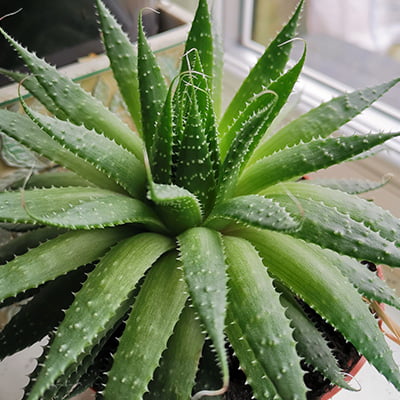
Aloe vera plants are perhaps the quintessential spiky plant. Not only are they beautiful, but they are useful! The gel inside aloe vera leaves soothe sunburns and encourage hair growth, and aloe vera juice boosts the immune system. It will start baby plants, called pups, all on its own - no propagation necessary.
If you have a shelf or windowsill that receives direct sunlight that would kill other houseplants, an aloe vera plant would love to grow there, and it thrives in sunny locations. Water aloe vera plants thoroughly every other week.
Height
1-2 feet
USDA Hardiness Zone
8-11
Sun Requirement
Minimum 6 hours of direct sun
Snake Plant

Snake plants (Dracaena trifasciata) go by many names, such as Saint George's Sword and Mother-In-Law's Tongue. Although all plants purify the air, and spiky plants are particularly good at it, snake plants may be the best. They have been shown to absorb pollutants that cause cancer, such as benzene and xylene.
Snake plants prefer brightly lit rooms but will handle direct sunlight or low light conditions if that's what you have available. Only water them if their soil has completely dried out.
Height
6-8 feet
USDA Hardiness Zone
9 -11
Sun Requirement
Minimum 5 hours of indirect Sunlight
Zebra Plant
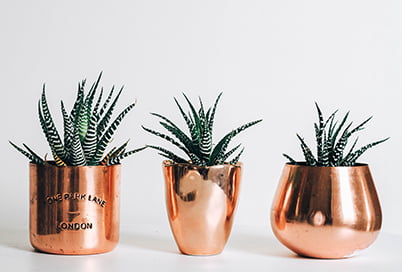
Zebra plants are the perfect desk companion, as many of the varieties only reach 4 to 6 inches tall. The variegated leaves are distinctly striped between deep green and bright white. They only need to water every couple of weeks and thrive in locations with plenty of sunlight.
Height
2 feet indoor and 6 feet outdoor
USDA Hardiness Zone
11 -12
Sun Requirement
Indirect to partial shade
Cacti
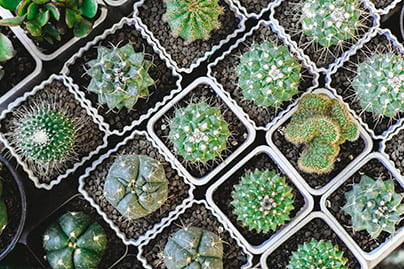
There are many species of cacti, and all of them are easy to maintain. They love dry air, one weekly watering, and lots of direct sunlight. You'll enjoy lovely pink or yellow flowers on their tops if allowed to grow to their full heights. However, remember that cacti have prickles that could cause a problem with pets or small children.
Here's a brief rundown of some of the best cacti to grow indoors or in rock gardens.
Cholla Cactus - Also called "jumping cactus," this species is particularly spiny! It gets its nickname because the tiny spikes easily detach from the plant.
Star Cactus - Star cacti is a uniquely lovely cactus that keeps a low profile, topping out at 6 inches. It doesn't produce notable spines, grows in a sectioned star shape, and blooms a single large flower in the center.
Blue Torch Cactus - This cactus specimen can get quite large if grown outdoors but lends a wonderful height to an indoor garden. It likes more humid conditions.
Brain Cactus - This is a small cactus plant, only reaching 6 inches in height. It's composed of thick folds that truly make it look like its namesake!
Fishbone Cactus - The fishbone cactus hardly looks like a cactus, with angular toothed stems that drape down. They do have a few spines and like humid conditions.
Bunny Ear Cactus - This cute little cactus puts out shoots that are shaped like little bunny ears! It's perfect for dry climates.
Spiral Cactus - Spiral cacti are relatively rare and are one of the fastest-growing cacti available. They bloom heavily and produce large purple fruit.
Santa Rita Prickly Pear Cactus - This cactus is quite the colorful showstopper! Its large oval pads turn a rich purple in winter, and yellow flowers decorate the edges of each pad during the spring.
Height
2 feet indoor and 6 feet outdoor
USDA Hardiness Zone
11 -12
Sun Requirement
Indirect to partial shade
Yucca
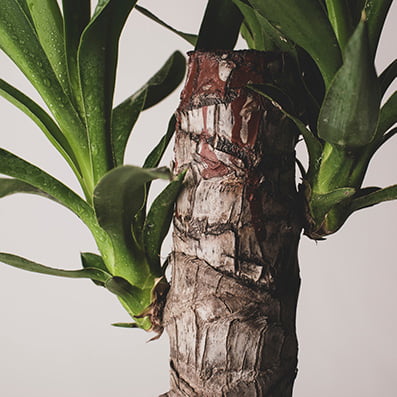
Yucca plants look similar to dragon trees (below) in that they grow as a tree with spiky leaves. They are slow-growing, which is great when they are kept indoors because they can get quite large! The leaves can range in color from yellow to deep green to a bluish-gray. They produce beautiful stalks of flowers if grown outdoors but likely won't bloom as indoor plants.
Spineless varieties are available and make great indoor options. All yucca varieties need ample bright sunlight and well-drained soil.
Height
Can Reach 30 feet tall
USDA Hardiness Zone
5 to 10, but certain varieties extend the range from 3 to 11.
Sun Requirement
Full sun to part sun
Dragon Tree
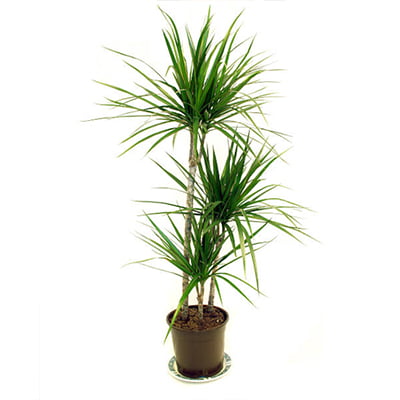
Related to snake plants, dragon trees (Dracaena marginata) are small trees with spiky green leaves edged with red. They are less tolerant of direct sunlight than some spiky plants on this list. They can grow up to 20 feet outdoors but are often pruned to 6 feet tall indoors. Wait until the top half of the pot is dry before watering, and keep an eye out for brown tips on the leaves. Dragon trees are sensitive to salt and fluoride in water, and you may need to use distilled water.
Height
up to 8 feet tall
USDA Hardiness Zone
9-12
Sun Requirement
bright indirect light
Best Spiky Plant Varieties For Outdoor
Agave
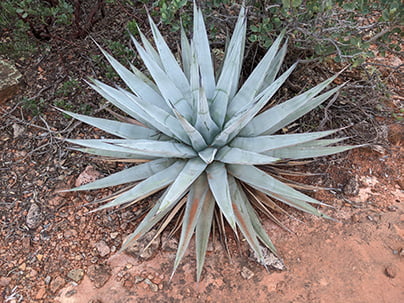
Agave plants range in size from small to truly massive. The leaves are greenish-gray, and their edges are rimmed with tiny spikes. They only flower once before dying, but after flowering, you'll find lots of tiny plants growing around the base of the parent plant. One variety, called the century plant (Agave americana), was named such because it was believed it took 100 years for it to bloom. We now know it only takes 25 years, but the show it puts on as it flowers is truly impressive.
Agave plants love strong sunlight and need to dry out between each watering fully.
Height
2-3 feet tall with some and reach up to 30 feet with flowers
USDA Hardiness Zone
8-9
Sun Requirement
At least 6 hours of direct sun
Devil's Walking Stick
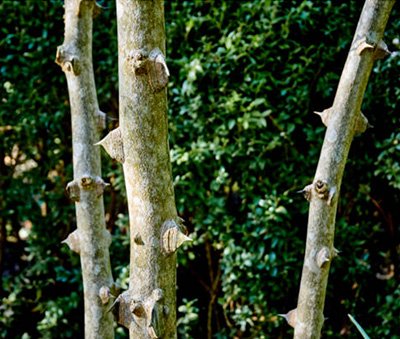
Also known as Hercules club and prickly ash, this plant produces attractive white flowers that draw bees and other pollinators. With long and sharp spines all over the stalks, stems, and branches, this is one of the best plants for home security.
Height
25 feet
USDA Hardiness Zone
4-9
Sun Requirement
full sun to part shade
Honey locust
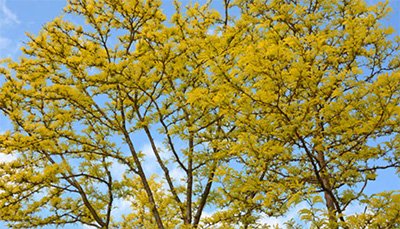
Native to North and South America, tropical Africa, and central and eastern Asia, the honey locust tree is a large tree that can reach up to 100 feet. This tree is often used for shade with dense foliage and has some of the longest thorns on the branches. For these reasons, most people don't want to mess with the tree, making it ideal for home security.
Holly Plants
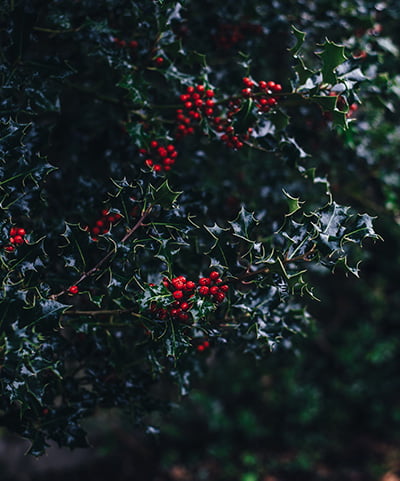
Holly is an evergreen tree that is often seen around Christmas time. This plant is a beautiful addition to the garden as a hedge or brush, and it will produce beautiful crimson berries. Holly plant is famous for being sharp. Not only are the leaves prickly, but it is also spiky throughout the plant.
Height
15-30 feet
USDA Hardiness Zone
5-9
Sun Requirement
full sun to part shade
